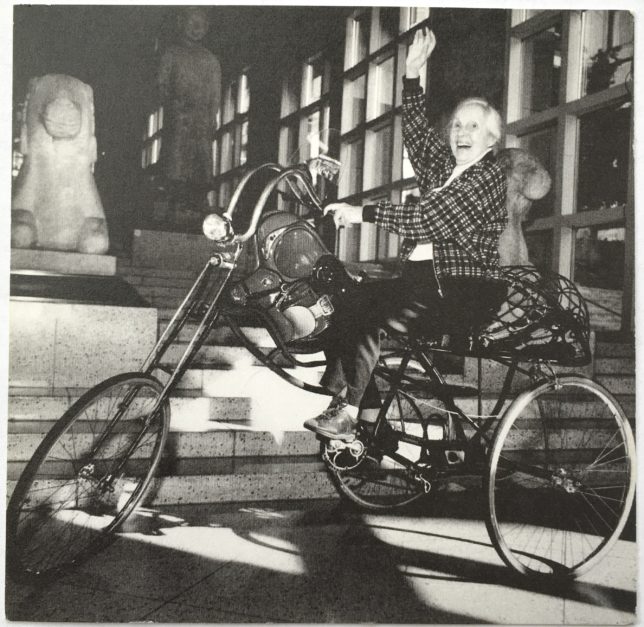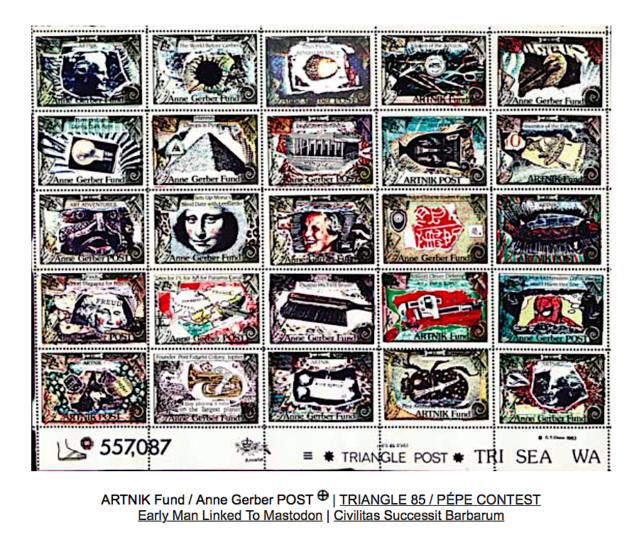August 13, 2019
My downstairs neighbor Kim dropped by this morning. He wanted help figuring out how to prepare himself psychologically for a visit later that day with his sister who had recently gone into hospice care. He wondered what he could do for her. What should he say, what could he take, how could he be ready? His questions brought back a powerful memory of my own, which I shared with him.
In the late ’90s a close friend of mine, Anne Gerber, was in the final decade of a long life. She was known for her unflagging support of artists and social causes. She called herself an “artnik” rather than an arts patron. She collected the work of risk-taking artists from across the country and world and was an avid supporter of local artists. She once said, “I like to watch for the art that’s discovering itself.” With her husband she worked to desegregate housing in Seattle and was a dedicated member of the ACLU. For me, she was proof that we don’t have to choose between art that matters and politics that matter or between a love of nature and a life of ideas. Remembering her, eco designer and artist Wendy Brawer wrote: “It was 1984. The phone rings, and the voice on the other end of the wire asks – what are you artists doing about the election? All it took was one nudge from Annie and we were off, running a creative campaign that brought our community into the political arena and sparked deep conversations on our rights and dreams as citizens.”

By the time she reached her early 90s, though, Anne’s eyesight was nearly gone and her mobility restricted. Living in a single room on the health-care wing of a continuing care retirement community, she was far from the friends she hadn’t outlived and didn’t get many visitors. The facility took care of her medical needs, but her social, cultural, and intellectual life suffered. She’d always been fiercely independent which kept her from reaching out when she wanted or needed something, and her failing eyesight kept her from reading and enjoying the art she loved. With very little social contact except for a group of five or six of us who visited whenever we could, her world got smaller. On my visits I began reading to her – sometimes choosing the latest art news and other timely articles about contemporary political events or people she knew. She liked feeling connected to worlds that mattered to her. I would watch her come back to life each time we were together.
After one of my visits, it occurred to me that she might enjoy hearing something from her own life. I remembered that, somewhere, I had an interview with her from the early 1980s. The Smithsonian’s Archives of American Art had wanted her oral history, and I’d agreed to do the interview. Anne and I had talked for at least an hour and a half on two different days. Afterward, I’d received a paper copy of the transcript, so I dug through my files to find it.
Before I visited again, I read through the stories she told – of her parents, her days as an art student, her marriage in Reno to Sydney Gerber, their sailboat summers in Canada’s inland passage where they became friends and supporters of renowned Kwakwaka’wakw carver Willie Seaweed, and many of her contemporary art world adventures, among which was a 1968 trip to New York with a charge from the Seattle Art Museum to find an exhibition that would be “new and fresh,” a search that led her to art critic and activist Lucy Lippard whom she signed up to be exhibition curator and who created for Seattle the first of what would be known as “Lucy Lippard’s Numbers Shows,” titled in our case 557,087.
The next time I saw Anne, I read aloud from the transcript for ten or fifteen minutes before I paused to look up. When I did, I noticed that she was sitting very still, listening intently, with a pensive, almost tearful look on her face. “I thought it was gone,” she said quietly. “But now it’s all back.” I read from that transcript many times on subsequent visits.

After sharing some of this with my neighbor Kim, I suggested that perhaps he could give his sister something that would trigger memories from her past. So much of our memory relies on recognition and has to be prompted to resurface, even when a memory defines us. Cues can be an object or a letter, a favorite song or the smell of a special meal. Or it might even be a question from a neighbor.
I bumped into Kim at the front door of our apartment building a few hours later. He was in a hurry but was carrying a big basket over his arm.
![]()
you are making me cry.
but with joy, too.
Your article reminded me of the time I sat in Gerber’s kitchen with her. I was a young struggling artist and a single parent, and rather scared. She looked at me and with a smile on her face said, “Carl, you will be just fine.” And she was right.
Thank you for bringing Annie back to us. I didn’t have the long connection but I encountered her over the years. I remember that indoor lap pool. How crazy that seemed to a 40-year old… and how gracious and open and unapologetic she was in her opinions with every visit we had together. How fortunate she was to have a forum through nobodies like us, and how brave she was to use it in her own way. Love to all, Chris Bruce
Loved her. What a force and what a gift to Seattle. I was honored to know her. Really honored that she had work of mine. Like Ries above, brings a tear to my eyes to think of her. Thanks for this remembrance Anne!!